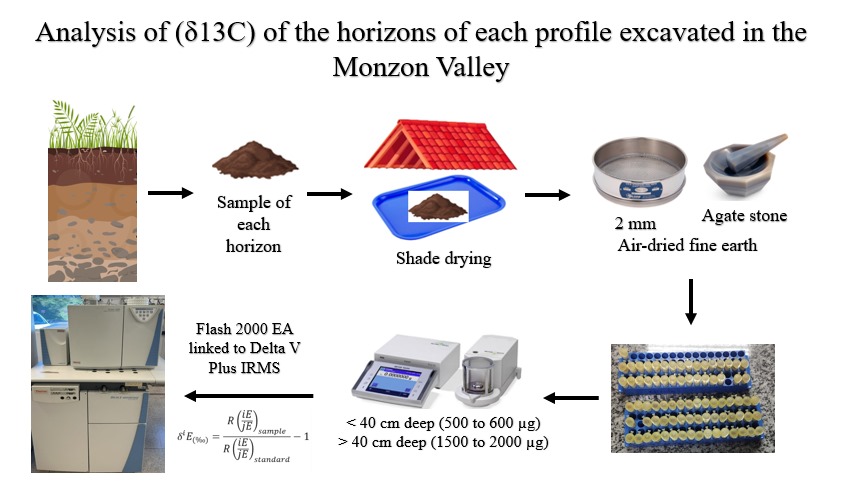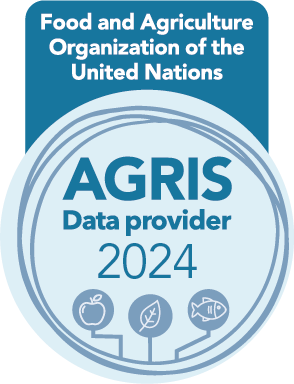Relationship between isotopic response (δ13C) and physicochemical properties: Taxonomy of soils in the Monzón Valley in the high jungle of Peru
DOI:
https://doi.org/10.17268/sci.agropecu.2026.008Keywords:
C3 and C4 photosynthesis, soil profiles, agricultural cropsAbstract
Identifying the carbon isotopic ratio is valuable for analyzing and understanding soil classification and dynamics. This study evaluated and related the soil isotopic ratio and its main properties (physicochemical) in the Monzón Valley. Fifteen pits were sampled within the strata of a toposequence. δ13C was determined using an isotope ratio mass spectrometry system coupled with an EA-IRMS elemental analyzer. To obtain accurate results, samples were categorized based on their depth. Between 500 and 600 µg of soil were weighed for samples <40 cm deep, and between 1500 and 2000 µg for samples deeper than 40 cm. The results provided information on the stable carbon content of the soil, separating each sample by its soil profile, depth, pH, color, Al, cultivar, carbon stock, taxonomic classification, among others. Differences in properties were found among the profiles studied, with quantitative variation in horizons, including the water table in some, and three soil orders. The δ13C ordering shows that Inceptisols exhibit mixtures of crops from C3 and C4 plants; this is likely due to historical human interference at certain depths. For Entisols, there is a lack of diagnostic horizon formation, with a predominance of C3 plants; however, in Alfisol the greatest uptake was in the surface horizon.
References
Barrezueta, S., Paz, A., Luna, Á., & Jaramillo, E. (2019). Variabilidad de δ13C y δ15N en suelo y hojarasca de cacao en El Oro, Ecuador. Terra Latinoamericana, 37(2), 131-140. https://doi.org/10.28940/terra.v37i2.202
Barrón, V., Mello, J., & Torrent, J. (2000). Caracterização de óxidos de ferro em solos por espectroscopia de reflectância difusa. In: Novais, R.F., Alvarez, V., V. H., Schaefer, C.E.G.R.(Eds.), Tópicos em ciência do solo (pp. 139-162). Sociedade Brasileira de Ciência do Solo.
Berriel, V., Mori, C., & Perdomo, C. (2014). Estatus hídrico y discriminación isotópica de 13C de dos pasturas convencionales de Uruguay. Agrociencia Uruguay, 18(2), 1-13. https://doi.org/10.31285/agro.21.365
Carrión, M., Espinoza F., Barrial A., & Ponce, Y. (2021). Influence of altitude and soil characteristics on organic carbon storage capacity of high Andean natural pastures. Scientia Agropecuaria, 12(1), 83–90.
Carvajal, A., Feijoo, A., Quintero, H., & Rondón, M. (2009). Carbono orgánico del suelo en diferentes usos del terreno de paisajes andinos colombianos. Ciencia del suelo y nutrición vegetal, 9(3), 222 - 235. http://dx.doi.org/10.4067/S0718-27912009000300005
Conrad, K., Dalal, R., Dalzell, S. Allen D., & Menzies, N. (2017). The sequestration and turnover of soil organic carbon in subtropical leucaena-grass pastures. Agriculture, Ecosystems & Environment, 248, 38–47. https://doi.org/10.1016/j.agee.2017.07.020
Contreras, J. (2021). Efecto de la aplicación de enmiendas cálcicas en las propiedades físicas, químicas y biológicas de suelos ácidos en Satipo (Tesis de pregrado). Universidad Nacional del Centro del Perú.
Coplen, T. (2011). Guidelines and recommended terms for expression of stable-isotope-ratio and gas-ratio measurement results. Rapid Communications in Mass Spectrometry, 25, 2538–2560. https://doi.org/10.1002/rcm.5129
Cruz, W., Rodríguez, L., Salas, M., Hernández, V., Campos, R., Chávez, M., & Gordillo, A. (2020). Efecto de la materia orgánica y la capacidad de intercambio catiónico sobre la acidez de suelos cultivados con maíz en dos regiones de Chiapas, México. Terra Latinoamericana, 38(3), 475-480. https://doi.org/10.28940/terra.v38i3.506
Dortzbach, D., Gervasio, M., Blainski, É., & Paz, A. (2015). Estoque de C e Abundância Natural de 13C em Razão da Conversão de Áreas de Floresta e Pastagem em Bioma Mata Atlântica. Revista Brasileira de Ciência do Solo, 39(6), 1643-1660. https://doi.org/10.1590/01000683rbcs20140531
Dortzbach, D., Gervasio, M., Novaes, L., & Paz, A. (2016). Horizontes diagnósticos superficiais de Cambissolos e uso de δ13C como atributo complementar na classificação de solos. Pesquisa Agropecuária Brasileira, 51(9), 1339-1348. https://doi.org/10.1590/S0100-204X2016000900033
Freixo, A., Machado, P., Guimarães, C., Silva, C., & Fadigas, F. (2002). Estoque de carbono e nitrogênio e distribuição de frações orgânicas de Latossolo do Cerrado sob diferentes sistemas de cultivo. Revista Brasileira de Ciência do Solo, 26, 425-434. https://doi.org/10.1590/S0103-84782012005000008
Fuchs, M., Cocilovo, J., & Varela, H. (2015). Análisis de la peleodieta a partir de los isópos estables del carbono y del nitrógeno en la población prehispánica de la puna de Jujuy (Argentina). Estudios atacameños, 51, 123-135. https://dx.doi.org/10.4067/S0718-10432015000200008
Gao, H., Gong, J., Liu, J., & Teng, Y. (2024). Effects of land use/cover changes on soil organic carbon stocks in Qinghai-Tibet Plateau: A comparative analysis of different ecological functional areas based on machine learning methods and soil carbon pool data. Journal of Cleaner Production, 434, Article 139854. https://doi.org/10.1016/j.jclepro.2023.139854
Gutiérrez, S., Jiménez, P., Guiomar, N., Caldeira, A., & Miller, A. (2024). Influencia de los incendios forestales en las comunidades microbianas y la calidad de la materia orgánica del suelo. XI Congreso Internacional FuegoRED, Salamanca.
Jackson, M. (1964). Análisis químico de suelos, primera edición. Omega, Barcelona. 662p.
Krüger, N., Finn, D. R., & Don, A. (2024). Soil depth gradients of organic carbon-13 – A review on drivers and processes. Plant and Soil, 495(1-2), 113-136. https://doi.org/10.1007/s11104-023-06328-5
López, W., Reynoso, R., López, J., Villar, B., Camas, R., & García, J. (2019). Caracterización físico-química de suelos cultivados con maíz en Villaflores, Chiapas. Revista mexicana de ciencias agrícolas, 10(4), 897-910. https://doi.org/10.29312/remexca.v10i4.1764
Martínez, A., Galarza, R., Intrigliolo, D., Martín, D., & Gonzaga, L. (2018). El ratio isotópico de carbono en viticultura: fundamentos de la técnica y utilidades. Enología y viticultura, 2, 20-25.
Neaman, A. (2024). Aspectos metodológicos para la investigación sobre el comportamiento de conservación de suelos. Idesia (Arica), 42(4), 86-94. https://dx.doi.org/10.4067/s0718-34292024000400086
Ouyang, N., Zhang, P., Zhang, Y., Sheng, H., Zhou, Q., Huang, Y., & Yu, Z. (2023). Cation Exchange Properties of Subsurface Soil in Mid-Subtropical China: Variations, Correlation with Soil-Forming Factors, and Prediction. Agronomy, 13(3), 741. https://doi.org/10.3390/agronomy13030741
Paul, D., Skrzypek, G., & Fórizs, I. (2007). Normalization of measu-red stable isotopic compositions to isotope reference scales – a review. Rapid Communications in Mass Spectrometry, 21(18), 3006–3014. https://doi.org/10.1002/rcm.3185
Paz, F., & Etchevers, J. (2016). Distribución a profundidad del carbono orgánico en los suelos de México. Terra Latinoamericana, 34(3), 339-355.
Raij, B., Cantarella, H., Quaggio, J., & Furlani, A. (1997). Recomendações de adubação e calagem para o Estado de São Paulo. 2.ed. Campinas, Brasil. Instituto Agronômico/ Fundação IAC, 285p. (Boletim Técnico 100).
Razanamahandry, V., Dewaele, M., Govers, G., Brosens, L., Campforts, B., Jacobs, L., Razafimbelo, T., Rafolisy, T., & Bouillon, S. (2022). Stable isotope profiles of soil organic carbon in forested and grassland landscapes in the Lake Alaotra basin (Madagascar): insights in past vegetation changes. Biogeosciences, 19, 3825-3841. https://doi.org/10.5194/bg-2021-336
Rhoades, J. (1982). Cation Exchange Capacity. En Page AL, Miller RH, Keeney DR (Eds.) Methods of Soil Analysis. Part 2. Agronomy Monographs Nº 9. American Society of Agronomy. Madison, WI, EEUU. pp. 149157.
Rolando, J., Dubeux, J., Pérez, W., Ramírez, D., Turin, C., Ruiz, M., Comerfor, N., Mares, V., García, S., & Quiroz, R. (2018). Soil organic carbon stocks and fractionation under different land uses in the Peruvian high-Andean Puna. Geoderma, 307, 65-72. https://doi.org/10.1016/j.geoderma.2017.07.037
Salazar, D., & Silva, V. (2017). Isotopos en la prehistoria y arqueologías valencianas. SAGVNTVM-EXTRA, 19, 75-91.
Schimmelmann, A., Qi, H., Coplen, T., Brand, W., Fong, J., et al. (2016). Organic Reference Materials for Hydrogen, Carbon, and Nitrogen Stable Isotope-Ratio Measurements: Caffeines, n -Alkanes, Fatty Acid Methyl Esters, Glycines, l -Valines, Polyethylenes, and Oils. Analytical Chemistry, 88(8), 4294–4302. https://doi.org/10.1021/acs.analchem.5b04392
Schimmelmann, A., Qi, H., Dunn, P., Camin, F., Bontempo, L., Potočnik, D., et al. (2020). Food Matrix Reference Materials for Hydrogen, Carbon, Nitrogen, Oxygen, and Sulfur Stable Isotope-Ratio Measurements: Collagens, Flours, Honeys, and Vegetable Oils. Journal of Agricultural and Food Chemistry, 68(39), 10852-10864.
USDA (United States Department of Agriculture). (2022). Keys to Soil Taxonomy, 13th edition. Washington, DC, USA: Natural Resources Conservation Service.
Vargas, Benedicto., Amezcua, Mayra., López, J., Cueto, A., Cruz, F., Nájera, J., & Aguirre, C. (2023). Estimación de las reservas de carbono orgánico del suelo en tres tipos de bosque templado en Durango, México. Ciencias Botánicas, 101(1), 90-101. https://doi.org/10.17129/botsci.3094
Yuan, T. L. (1958). Determination of Exchangeable Hydrogen in Soils by a Titration Method. Florida Agricultural Experiment Station.

Downloads
Published
How to Cite
Issue
Section
License
Copyright (c) 2025 Scientia Agropecuaria

This work is licensed under a Creative Commons Attribution-NonCommercial 4.0 International License.
The authors who publish in this journal accept the following conditions:
a. The authors retain the copyright and assign to the magazine the right of the first publication, with the work registered with the Creative Commons attribution license, which allows third parties to use the published information whenever they mention the authorship of the work and the First publication in this journal.
b. Authors may make other independent and additional contractual arrangements for non-exclusive distribution of the version of the article published in this journal (eg, include it in an institutional repository or publish it in a book) as long as it clearly indicates that the work Was first published in this journal.
c. Authors are encouraged to publish their work on the Internet (for example, on institutional or personal pages) before and during the review and publication process, as it can lead to productive exchanges and a greater and faster dissemination of work Published (see The Effect of Open Access).




